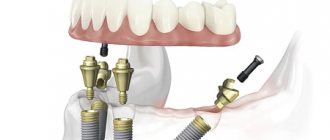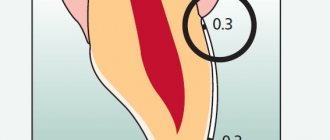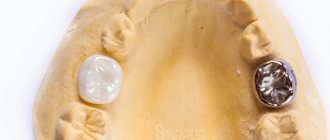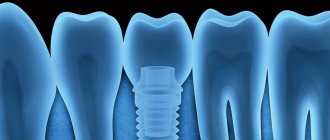Implants used to restore lost teeth appeared several decades ago. And work on their improvement continues to this day. Experts are interested in both increasing reliability and durability, as well as high-quality integration with living tissues.
It is equally important to get an excellent cosmetic effect after installing even the most budget-friendly artificial roots. The result of the work of analysts and dental practitioners has been the emergence of a wide range of implants used to restore the aesthetic and chewing functions of the maxillofacial apparatus.
History of the first patient
The first attempts to replace lost teeth with artificial ones were made by people in antiquity and even earlier. In the form in which we know dental implants now, they appeared in the second half of the 20th century. The first successful implantation was performed in 1965 on an ordinary carpenter, Gust Larsson, who lost all his lower teeth at the age of 34, had a cleft palate, a deformed upper jaw and chin, and experienced constant pain and significant difficulty eating and speaking. Larsson volunteered for a new study led by Professor Ingvar Brånemark at the University of Gothenburg, which Güsta had heard about by chance from his dentist. After the treatment, he was able to chew, eat and speak normally. The installed implants served Gust Larsson all his life. The experience of this brave man proved that installing dental implants is the most effective way to restore lost teeth.
Options for the number of lost teeth
The method of restoration is determined depending on the number and location of lost teeth. Only the attending physician will answer the question of what to choose. The table shows general indications:
| Pathology | Implants | Removable dentures | Dental bridges |
| 1 tooth missing | Yes | yes, if the patient does not want to grind healthy crowns | Yes |
| Several teeth missing in a row | Yes | Yes | Yes |
| Scattered defects | Yes | depends on the length and location of defects | Yes |
| End defect | Yes | No | No |
| Completely edentulous | Yes | Yes | No |
Dental implants – what are they?
Dental implants, implants, implants are all artificial structures that replace missing teeth. They are firmly fixed in the bone tissue of the jaw and serve as a reliable support for fixed or removable dentures in the form of single crowns and bridges of varying lengths (you can see what dental implants look like in the photo above). There are several types of dental implants, but the most popular today are root-shaped dental implants, which have earned favorable reviews from both patients and leading implantologists around the world. Prices for dental implants depend on their quality, features of the installation system, the presence of special coating and other factors. Which implants are better is a topic for a separate article.
About the disadvantages of implantation
From the outside, implantation may seem like an ideal technique, and in many ways it is - with the exception of a few points. The disadvantage of implantation is not only the high price, but also limitations during the procedure. There are a number of contraindications in the presence of which dental implantation is not recommended or cannot be carried out in principle. In case of absolute contraindications, alternative methods remain the only option.
If a sufficient volume of bone tissue is preserved, prosthetics on dental implants does not present any difficulties and allows the patient to obtain the maximum expected functional result and better aesthetics.
In cases where the volume of bone tissue does not allow the installation of an implant, additional osteoplastic operations are required to restore it. In some cases, plastic surgery of the gingival margin may be required, especially if the patient has high aesthetic needs. In the postoperative period, soft tissue swelling and pain are possible.
If treatment is carried out according to the classic two-stage protocol, the implant is installed in the bone tissue, and sutures are placed on the mucous membrane above it. After surgery, the healing process (waiting for the implant to integrate into the bone) can take from several weeks to several months. Then the second stage, additional surgery, is performed. The implant is opened, the external parts are fixed on it, and the orthopedic stage of treatment begins, the manufacture of the actual dentures. Not everyone is ready to wait that long.
There are options for installing an implant during tooth extraction and immediate fixation of a temporary prosthesis on the installed implant. The choice of technique is made by the doctor, based on each specific case.
Structure of a dental implant
A root-shaped implant, as mentioned above, is the most common and sought-after type of dental implant. What does a dental implant consist of? Root-shaped structures have three parts: root, abutment and crown. A titanium rod replaces the root of a lost tooth. The abutment externally is an artificial tooth ground for a crown. It serves as a link between the components of the implant - the rod and the prosthesis, and is also the basis for the latter. Root-like artificial roots are divided into cylindrical and helical. The latter are more in demand in implantology, as they have a thread applied to their surface, which contributes to a more durable fusion of the titanium rod with the jaw bone. Dental implants come in different sizes – they can be short or long, thick or thin. See the photo below for what a dental implant looks like.
Photo of a dental implant
Why is it important to restore missing teeth?
Each lost crown along with the root threatens complications:
- Malocclusion - neighbors in the same row shift towards the empty socket. On the opposite side, on the other jaw, they move up or down. In this case, the rows do not close as expected.
- Diseases of the temporomandibular joint with headaches and tension in the muscles of the face and tongue.
- Digestive disorders - when there is nothing to chew, food is swallowed in rough pieces. Salivary enzymes do not have time to break down carbohydrates, and the function of the stomach, pancreas and duodenum is impaired.
- Changes in the shape of the face - a person looks older, facial wrinkles appear near the lips, cheeks sag and sag.
- Destruction of neighboring teeth, on which the chewing load increases.
- Bone atrophy and subsidence of the gingival papilla.
- Speech defect - there is a lisp and nasal sound.
- Psychological discomfort - lack of self-confidence, withdrawal from other people.
It is important to restore lost teeth. The doctor will tell you which method is best during your consultation, depending on your specific situation. The choice is yours.
How do dental implants take root?
What material are dental implants made of? The answer to this question will help us understand why they take root well. Almost all of the newest dental implants are made from titanium. This unique material is ideal for the manufacture of artificial tooth roots, since it is not perceived by the human body as something foreign and is not itself subject to the destructive effects of the surrounding biological environment. But the most important thing is that it can reliably fuse with the jawbone. These unique properties of titanium solved the problem of rejection and made implantation a reliable and durable technique. However, in very rare cases when a patient is allergic to titanium dental implants, zirconium dioxide is used as a base to make the prosthesis.
How long does it take for a dental implant to take root? Experts believe that the survival of dental implants is an individual process. The timing of osseointegration depends on the area of the dentition in which the implantation was performed, as well as on the quality of the bone tissue. In general, the healing of dental implants lasts from three months on the lower jaw and up to six months on the upper jaw. If the implantation is successful, then removal of the prosthesis becomes almost impossible, which proves the reliability of the structure. What is the survival rate of dental implants that worries many patients? It varies among different manufacturers, but in general it does not exceed 5%. In addition, the success of the operation is also influenced by the skill of the implant surgeon, so the choice of dentistry should be approached with special care.
Contraindications for implantation
Before performing an implantation procedure, the dentist must check the patient for possible contraindications. They are divided into several varieties.
Absolutes include the following:
- blood diseases;
- if there are malignant tumors;
- with immune pathology;
- if there are diseases of the central nervous system;
- if bisphosphonates are taken orally;
- in the presence of lupus erythematosus, rheumatoid arthritis, rheumatism, scleroderma;
- if you have tuberculosis;
- if there is recurrent stomatitis or pemphigus;
- if the function of the masticatory muscles is impaired;
- diabetics.
Relative contraindications include the following:
- Lack of oral sanitation.
- Poor oral hygiene (this is a good reason to prescribe removable dentures).
- For gingivitis.
- If there is marginal periodontitis.
- For pathological bites.
- For diseases of the temporomandibular joint.
- If there is severe atrophy or damage to bone tissue.
- If the patient smokes, drinks alcohol and drugs.
- When pregnant.
General contraindications consist of the following:
- Surgical reasons for refraining from any intervention.
- Contraindications to pain medications (negative tolerance to anesthesia).
- Certain somatic diseases that may be affected by the procedure (these include endocarditis and other heart diseases, rheumatism, etc.).
- Certain treatment methods can have an impact on the regeneration and preservation of the dental element after installation, on the tissue surrounding the dental element (if various types of depressants, anticoagulants, cytostatics and other agents are used).
- Diseases of the central nervous system.
- Distress syndrome (severe and prolonged stress, which is caused by all sorts of reasons).
- If there is exhaustion of the body.
- Poor oral hygiene (this is a good reason to prescribe removable dentures).
Local contraindications consist of the following:
- unsatisfactory tendency to oral hygiene;
- insufficient presence of bone tissue or its inappropriate structure;
- unsatisfactory distance to the maxillary and nasal sinuses.
Temporary contraindications include the following:
- acute diseases;
- rehabilitation and health stages;
- pregnant condition;
- addiction;
- condition after irradiation (the implantation procedure can be done after a year).
Lifespan of dental implants
Although implantation is significantly more expensive than traditional prosthetics, with a long-term calculation the costs are equalized. This is due to the fact that traditional bridges, crowns, clasp or nylon dentures need to be replaced on average every 5 to 7 years, and the supporting teeth will have to be ground down again each time. How long does a dental implant last? The minimum service life of a dental implant is about 30 years, and if all the doctor’s instructions are followed, the implant will last you a lifetime. Most manufacturing companies, including world industry leaders, who invest considerable funds in the latest developments, provide a multi-year or even lifetime warranty on their products. This applies to the part of the structure that is located inside - that is, the root (base plate, etc.) and the abutment. A crown installed on an abutment has a more limited service life, but it is also significantly longer than that of a traditional prosthesis installed on ground natural teeth. This is on average 10 – 15, sometimes 20 years. If we are talking about implantation for a young person, then, of course, he will be interested in what happens to implants in old age. With proper care and preventive examinations, nothing should happen to the artificial root.
Possibilities of a conditionally removable denture supported by natural teeth
A fixed bridge supported by your own teeth will help replace 1 to 4 missing teeth in a row. The undoubted advantage of such dentures is a better restoration of chewing function compared to removable dentures, the absence of discomfort and good aesthetic characteristics. Bridges do not need to be maintained or adjusted: up to a certain point, the patient may not notice them at all. Of course, this design will also cost significantly less than an implant-supported prosthesis. But there are some nuances here too.
✔
With a classic bridge, only a few teeth can be restored, because the supporting teeth also need to be taken into account. For example, to replace 1 tooth, the patient is given a prosthesis on 2 supporting teeth.
✔
Abutment teeth (even completely healthy ones) must be ground down for crowns.
✔
In this case, the tissues surrounding the tooth, the so-called periodontium, have an increased chewing function, taking on the load of the missing tooth. Over a long period of operation, the reserve forces of the periodontium of the supporting teeth will weaken, which, as a consequence, sooner or later will lead to their loss. That is why the service life of bridges, as a rule, does not exceed 7-10 years.
General and specific contraindications
Who is contraindicated for dental implants? Implantation is a surgical operation and, like any other operation, it has contraindications. They are divided into two types: general for any type of implantation and specific dental ones.
The following concomitant diseases are common to all types of implantation (and to surgical interventions in general):
- violation of coagulation (blood clotting), diabetes mellitus, tuberculosis, chronic rheumatism - these diseases complicate wound healing and implant placement;
- pregnancy and lactation;
- childhood and adolescence – children and adolescents continue to grow, and this is fraught with displacement of implants or their rejection, or slowdown in the growth of individual organs as a result of the installation of dental implants in them;
- diseases of bone tissue that reduce its regenerative abilities;
- diseases of the nervous system;
- cancer during exacerbation, HIV and AIDS, specific diseases of the immune system that weaken the body as a whole and do not allow it to recover after operations.
The following can be considered specific contraindications to dental implantation:
- when installing implants in the upper jaw, it is necessary to take into account such factors as the proximity of the sinuses (aka the maxillary sinuses), as well as the width and density of the bone at the point of contact of the jaw with the sinuses; in some cases, the implantation procedure may be preceded by a sinus lift;
- chronic, including inflammatory diseases of the oral mucosa;
- patient's failure to comply with oral hygiene;
- insufficient height and density of bone tissue at the site of proposed implantation (this applies to both the upper and lower jaws) - in such a case, bone grafting can correct the situation.
It is worth noting that diabetes and advanced age are not currently included in the list of contraindications for dental implantation.
Dental implants in the upper jaw
Stages of the implantation procedure
In modern times, implantation is carried out in several stages. This is more preferable for dentists and patients. The procedure is divided into the following stages:
- Initially, the patient is pre-consulted to identify contraindications and indications for the procedure. Dental, social and somatic factors may serve as contraindications.
- Then a detailed diagnosis is made using computed tomography and stereolithography. At this stage, the entire procedure is planned.
- Treatment measures are discussed with the client. He is provided with detailed information about the procedure and an agreement is concluded between the dental clinic and the patient.
- Dental therapists, orthodontists and periodontists prepare the workplace for the procedure.
- During the procedure, bone tissue may or may not be built up, and alveolar ridges and jaw bones may also be reconstructed. If necessary, they can make a somatic correction. Indications for the use of correction are the presence of diabetes mellitus and other diseases.
- At this stage, an implant is installed, defects are removed and the functions of the musculoskeletal system are restored.
- As a result of the procedure, the patient’s condition is monitored and a preventive examination is performed.
Caring for Dental Implants
Many patients who have had artificial teeth installed are concerned about the question: how to care for dental implants? In fact, caring for artificial teeth is practically no different from regular oral hygiene. The same few basic rules apply here: regularity, thoroughness, correctness. That is, you need to brush your teeth at least twice a day - in the morning and before bed, and preferably after every meal, especially after eating carbohydrates; this must be done for at least three minutes, and also use additional hygiene products: dental floss, irrigator, etc.; You need to brush your teeth correctly - with sweeping movements away from the gums. The same brushes that are used for cleaning natural teeth are suitable for cleaning dental implants, but you can purchase a special toothbrush for implants.
How many implants are needed to install a prosthesis?
➢
Restoration of several teeth. It is optimal when implants replace every lost tooth. If 3 teeth are missing, we install 3 implants and replace each implant with a separate crown. We get maximum and natural restoration of chewing function and the best aesthetic result. It is possible to install 2 implants when replacing 3 lost teeth - this is already a bridge prosthesis. The chewing function is restored completely, but restoration of ideal aesthetic parameters can be difficult, as well as hygiene.
➢
Restoration of a completely toothless jaw
- Conditionally removable and removable dentures on implants.
When rehabilitating patients with complete edentia, it is not always possible to make a fixed dental prosthesis supported by implants. With prolonged absence of teeth and when using complete removable dentures, atrophy of the alveolar process and narrowing of the dentition occur. In the absence of the required volume of bone tissue and mucous membrane of the alveolar process, especially in the lateral parts of the jaws, implants as a support for a conditionally removable denture can be installed in the front part of the jaw. The base of such a prosthesis can imitate part of the mucous membrane, which creates an additional cosmetic effect. There are different types of fixation of conditionally removable plate prostheses supported by implants: a beam fixation system, fixation of the prosthesis on ball-shaped abutments, a telescopic system, etc. - Fixed dentures on implants.
If there is a sufficient volume of bone tissue or if teeth are removed simultaneously with the installation of implants, it is possible to manufacture permanent structures on implants. These types of dentures have all the advantages over removable and conditionally removable dentures supported by implants.
- There is no need to remove the denture from the mouth after each meal.
- Reliable fixation of crowns in the oral cavity.
- The shape and size of crowns follow the anatomical shape and size of their teeth. In this case, the chewing load is evenly transferred to the bone tissue surrounding the implants, which allows 100% of the chewing function to be restored. All this makes implant-supported fixed prostheses comfortable and convenient for the patient, so adaptation to such designs occurs as quickly as possible.
In case of complete loss of teeth, prosthetics on dental implants can be carried out in different options.
- “All on 4” is the most gentle technique with the installation of 4 implants and fixation of a fixed prosthesis on them. Surgical intervention in this case is minimal and is carried out using a special surgical template through a puncture of the mucous membrane in the area where the implant is installed.
- Installation of 6-8 implants and subsequent prosthetics with a fixed prosthesis made of metal ceramics and zirconium dioxide.
- Installation of 8 or more implants and fixation of fixed bridges or single crowns made of metal ceramics or zirconium dioxide on them. Today, dentistry has entered the age of digital technology and computerization. Advanced CAD/CAM systems allow you to achieve maximum speed and accuracy in the manufacture of implant-supported orthopedic structures.
Compromises in the cost of final treatment include the choice of the option of fixed prosthetics on implants made of different materials: this is the production of metal-ceramic structures, zirconium with veneer and all-zirconium structures.
To reduce the patient’s financial costs for the manufacture of implant-supported fixed dentures for a toothless jaw, you can consider the concept of patient rehabilitation “All on 4” and “All on 6”, as well as a shortened dentition.
Prices for dental implants in Moscow
As with any other area of dentistry, the cost of dental implants varies widely. On average, the price for installing one dental implant in Moscow ranges from 15,000 in economy class dentistry to 80,000 rubles in a VIP clinic. Moreover, the budget required for the implantation procedure as a whole largely depends on the cost of the implant. In order to understand how much a dental implant costs and which price is acceptable, which is unreasonably high, and which is suspiciously low, it is necessary, first of all, to understand what it consists of.
Non-surgical dental implantation
Dental implantation in dentistry can be carried out using various methods. The methods for performing this operation were described above. Non-surgical methods for installing a dental element are express methods, which include lateral, one-stage and others.
This non-surgical method is also called one-stage, seamless, with minimal risk of injury. With this technology, tissues are practically not injured. In this case, there is no need to build up bone tissue and the stress on the gums and healthy teeth is minimal.
Express methods include the following:
- Instant installation of implants. In this case, the dental element is installed immediately after the diseased tooth is removed.
- Implantation with immediate loading is the main express technology. In this case, one-piece structures are used. They are fixed with minimal traumatic risk.
- Mini-implantation involves the use of small-sized implants. They are auxiliary fixators of removable dentures. This is necessary in order to prevent them from slipping out of the mouth and making them more comfortable to wear.
In modern times, one of the most popular and in demand is implantation with instant loading.
Reasons for the high cost of dental implants
Material and price of dental implants
The main material for manufacturing dental implants is titanium alloy. Titanium is bioinert, that is, it is not perceived by the human body as a foreign element and is not influenced by the surrounding biological environment. Thanks to its unique qualities, dental implantation has become a reality of modern dentistry. But this is not the only material from which implants are made. In special cases, zirconium oxide can be used as a base; this occurs when the patient is allergic to titanium. With regard to the material of manufacture, prices for dental implants depend on the purity of the alloy and the presence of a special coating that helps make the healing process faster and more reliable. It is worth noting that the above-mentioned zirconium oxide is a more expensive material than a medical titanium alloy.
Manufacturability determines how much a dental implant costs
The type of implants that have a root-like shape have long been recognized as the most reliable and physiological. Many of them have special grooves on the surface. But some systems have additional technological advantages and a more advanced form, which speeds up healing, expands the possibilities of implantation and subsequent prosthetics on implants, and also prevents bone resorption and provides better support for the soft tissue of the gums around the implant. Thanks to this, an artificial tooth serves a person throughout his life and looks as natural as possible. It is not difficult to guess that the more technologically advanced the implant, the more expensive its cost.
Overpayment for the brand or adequate price of dental implants
Undoubtedly, the brand of certain implants affects their cost. However, you should not think that in the case of an implantation system from well-known manufacturing companies you are overpaying for the brand. As a rule, world industry leaders provide a multi-year, and in some cases, a lifetime warranty on their products. Also, large manufacturing companies invest considerable funds in the latest research and development, which allows them to perfect the quality of implants, as well as develop the most effective solutions to problems arising in modern implantology.
About implant brands and price differences
The most expensive implants are those made in Europe and the USA, but this does not mean that they have no alternative. We recommend paying attention to South Korean implants. Many are quite skeptical about products from Asia, but the medical industry of South Korea is not inferior to leading Western countries in terms of technological solutions. One of the best South Korean implant systems is Osstem. The company offers a wide range of implants and abutments that can solve the problem of partial and complete tooth loss in patients of various age and social groups. The possibility of 3D planning and the availability of special sets of tools for installing Osstem implants in conditions of bone deficiency makes it universal.
It is very important that the selected company producing implants has a distributor in your city who would not only sell this system, but also conduct courses, seminars, master classes and provide all the necessary technical support to doctors and patients. There is no need to save on your health by trusting systems that have not received a license and do not have official representation in Russia.
Dental implants – pros and cons
As for expert opinions, the majority of specialists are inclined to argue for dental implants, and those who are usually against are either very elderly doctors or dentists who do not have sufficient qualifications to carry out such procedures. If we consider the pros and cons of dental implants, then among the undeniable advantages we can note durability, the absence of the need to grind adjacent teeth, in contrast to the installation of bridges, as well as the preservation of all the functions of a natural tooth, such as: full participation in chewing and speech, prevention of tooth loss bone tissue and changes in facial features. As for the disadvantages, the price becomes a significant difficulty for most patients, however, as mentioned above, this is an adequate cost of solving the problem once for a lifetime. As for an alternative to dental implants, it does not exist as such, since traditional prosthetics is inferior to it in all respects.
Dental implants make it possible to improve the quality of life, restore the full functionality of the dentition, restore the attractiveness of the smile, and also protect yourself from the loss of bone tissue in the place of the missing tooth, and therefore from the possibility of losing neighboring teeth. But, in any case, only an implantologist can confirm the need for this operation; he will also help you draw up a treatment plan and choose designs that suit you personally.
Doctor's advice - removable structures cannot compare in quality with an implant.
If you decide whether a removable denture or an implant is better, the choice is obvious. Removable structures cannot compare in quality to an implant. They need to be serviced every year, while an implant will last ten years without updating. Not all removable models are securely attached. In terms of comfort, removable structures are also inferior to implants. The latter do not bring discomfort to the patient, do not rub the gums and feel like natural teeth after just a couple of days.
Levin Dmitry Valerievich
Chief physician, Ph.D.











